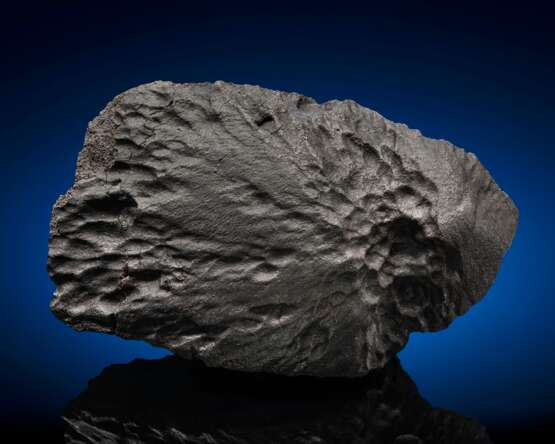ID 491252
Lot 42 | SPECTACULAR ORIENTED STONE METEORITE
Estimate value
$ 50 000 – 80 000
To enable scientists to refer to individual meteorites, there must be a nomenclature system in place. So meteorites are named after the localities where they fall, but in the desert, where there are few distinguishing geological features, meteorites are named after the designated grid in which they are found and are assigned sequential numbers. A small sample of the current offering (removed from the reverse) is currently undergoing analysis by Dr. Carl Agee, the Director of the Institute of Meteoritics and among the world’s foremost experts in meteorite classification. As this meteorite was found in the North West African grid of the Sahara Desert, it will be assigned a name that commences “Northwest Africa” (NWA) followed by a unique number. Researchers' findings are then peer reviewed and, upon consensus of the specimen’s petrography, geochemistry, type and classification, the meteorite is named and published in the Meteoritical Bulletin — the bible of meteorites. Dr Agee's preliminary analysis indicates this is an H4 or H5 chondrite.
The face is covered in fusion crust. Regmaglypts (aerodynamic flight marks) are embossed into the right side of this elongated specimen radiating out of a socket. The flowlines and attenuation of the regmaglypts make it clear that while blazing through Earth’s atmosphere, the left side of this specimen slightly trailed the right side and that the surface currently facing you, was facing Earth during its descent. This meteorite broke at a very high altitude as secondary fusion crust on the meteorite’s bottom surface is in evidence. The reverse reveals chondrules and other inclusions in a walnut-hued matrix spotted with sandy patches — the result of its residency in the Sahara. In an abundance of caution, a partial crack has been stabilized. A small cut window at the meteorite’s base is where the classification specimen was removed and a variegated matrix filled with metal flake is seen (see second image). This feature is diagnostic in the identification of a meteorite, and in this instance an exquisite oriented meteorite which appears as if it’s still in flight.
Christie's would like to thank Dr. Alan E. Rubin at the Department of Earth, Planetary, and Space Sciences, University of California, Los Angeles for his assistance in preparing this catalogue.
127 x 271 x 119mm (5 x 10.75 x 4.66 in) and 7.160 kg (15.75 lbs)
| Address of auction |
CHRISTIE'S 20 Rockefeller Plaza 10020 New York USA | ||||||||||||||
|---|---|---|---|---|---|---|---|---|---|---|---|---|---|---|---|
| Preview |
| ||||||||||||||
| Phone | +1 212 636 2000 | ||||||||||||||
| Fax | +1 212 636 4930 | ||||||||||||||
| Conditions of purchase | Conditions of purchase | ||||||||||||||
| Shipping |
Postal service Courier service pickup by yourself | ||||||||||||||
| Payment methods |
Wire Transfer | ||||||||||||||
| Business hours | Business hours
|



